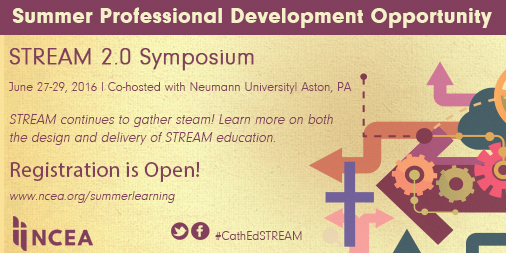This post was contributed by Ann Kaiser CEO of ProjectEngin LLC.

The Archdiocese of Newark has several programs underway in order to support schools committed to incorporating Engineering and more active learning techniques into their STEM curriculum. The teachers and schools involved in these programs are committed to encouraging students to see the creative potential of engineering and science to solve problems, meet global challenges, and improve our lives.
The programs have involved professional and curriculum development provided by ProjectEngin, a STEM education consulting firm. Five teachers who have been involved in programs during the 2015-16 academic year will join Ann Kaiser, CEO of ProjectEngin, on a panel at the STREAM 2.0 Symposium.
Some participants have been involved in initiatives aimed at supporting the use of the Engineering Design Process in science classes from grades K-12. They have made changes that have ranged from the inclusion of simple “Quick Build” activities, designed to introduce concepts in a hands-on manner, through more extensive Engineering Design challenges. All have used classroom practices developed to support creativity, divergent thinking, and collaboration and will be sharing their experiences as part of the panel discussion.
The most intensive program offered this year was designed to enable teachers to develop customized Engineering courses at the high school level. These courses will debut at 11 high schools this fall and were created by the teachers through a series of workshops and training sessions. Support will continue through the 2016-17 academic year.
Michael Kennedy of Roselle Catholic High School, participated in both programs and will be teaching an Engineering course this fall. He summarized some of his experiences this year as follows:
For me, using engineering in my classroom is a new and exciting approach to learning for the students which will enable them to think outside the box and come up with some really creative ideas. I have tried the engineering process with my AP Chemistry class when they designed a water desalination plant when we were discussing the topic of solutions and electrolytes. The students had to prototype a plant before they could start building, and for some of them that was a challenge because it required them to think through the process before they could act. The students who were involved in the activities I did in class were at first skeptical because it was something different, but when they realized they could use their imagination to come up with their own solutions they were enthusiastic. My colleagues and administrators are very supportive and eager to see how this course will take effect next school year. I have graduating seniors and alumni who have heard of the course come back and tell me they wish this course was offered while they were here!
Samantha Scutieri has great plans for her new Engineering course at Union Catholic High School and she finds that it has sparked further interest in STEM offerings:
Next year, in our Engineering course, I plan to have the students delve into projects that investigate transportation methods, circuitry, programming and CAD design, and water. Students have expressed a lot of excitement that this course is coming, and many graduating seniors were sad that they missed it. Between others talking about engineering at school, as well as the beginnings of a makerspace at my school, we are also going to have a robotics course next year. Once we get past the intro part and into project-based challenges, I plan to use the Engineering Design Process that has been a part of our experience with Ann’s workshops in that course, too. I was able to do a VERY abbreviated example of this process with some faculty members’ children and grandchildren that visited my school during Take Your Child to Work Day and they had a great time learning in this way.
Changing STEM programs and curriculum is truly a multi-faceted, evolutionary process. The Archdiocese of Newark has made a major commitment to this process by clearing supporting the two key parts of the process – dedicated teachers and engaged students.